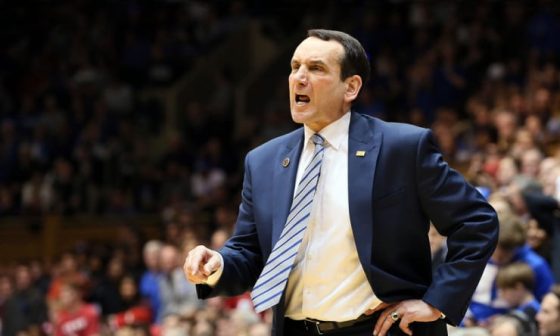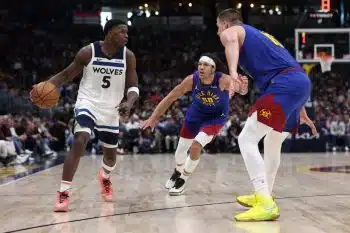NBA
Curved Grades: On Complacency Hurting Team USA

Remember high school teachers or university professors who graded on a generous curve? Not the sticklers in competitive courses who used the curve to weed out the less worthy. We’re talking about the converted gym teacher who lumped anyone with 75 percent or better into the “A” category and went out of their way not to fail anyone. To some among us these teachers were a godsend, an easy GPA booster, a convenient chance for a nap.
To the more motivated – and likely to many parents – they were a dumbed-down waste of time. It was too easy to succeed. If there’s no difference in the bottom line for a student in the 75th percentile versus one in the 95th, what’s the motivation to do anything but the bare minimum?
If curves like these became too common, many could find it bleeding into our other classes. Laziness and settling can easily become habits for even the most diligent.
Since 1992, the United States men’s basketball team has operated within a constantly curved grading system – one where only they get the gym teacher and every other country gets the stickler. And while they’ll likely get another “A” in the form of a gold medal Sunday, the path here has perhaps exposed the level to which their comfortable pattern has led to coasting and complacency throughout the process.
It’s not tough to see how things got to this point. The program hasn’t lost a game in a decade after overhauling things following its mid-2000s embarrassments, and now sits a win over Serbia away from sweeping three consecutive Olympics. The victories have typically been sleepy affairs, with most exceptions caused by laziness and rectified through a flip of the on-switch. Guys only used to playing with each other in meaningless All-Star games naturally have a hard time adjusting, even if that reality almost never shows through with such an overwhelming talent advantage.
The gap was narrower than usual this time around, and it showed.
The team’s first halftime deficit in the better part of a generation against Australia sticks out, as does a narrow three-point win over Serbia two days later. Both these games were in legitimate doubt, and it wasn’t because of some unreal shooting barrage from the opposition.
USA’s defense has looked lost for long stretches against teams with real NBA talent. The group has appeared disjointed ever since that Australia game, even at times during a couple more comfortable medal round wins. After facing little adversity or scrutiny since helping right the ship 10 years ago, coach Mike Krzyzewski has shown a few chinks in the armor.
Part of it wasn’t really anyone’s fault, to be fair. Other countries dealt with a number of notable absences from Rio, but none had to stomach losing arguably six or seven of their eight best players, including several mainstays from previous triumphs. The U.S. has commonly been at a continuity disadvantage against teams like Spain or Argentina with cores who literally grew up playing together, and they may have felt that even more this year.
The talent has always been enough to override that, though. It should have been this year, too, at least to a larger degree than we’ve seen.
Part of the issue is team construction, especially in a year when so many of the top guys stayed home. Those are the guys capable of overwhelming anyone regardless of fit, matchups, shooting slumps, whatever. So many of them were gone, yet the approach remained the same, and that’s the problem.
Take DeMar DeRozan, for instance – a great player, an All-Star in his prime. This isn’t an All-Star team, though. On a roster already loaded with scoring and ball dominance, what’s the need for depth pieces with overlapping skill sets and few complementary talents at this level? DeRozan doesn’t shoot threes, isn’t a great defender at his position and has only played previously on the international stage with three of his eleven teammates.
Instead of the next big name down the list when the superstars bow out, why isn’t fit being considered more for these depth roles? Could someone like Milwaukee’s Khris Middleton, a great defender and spot-up shooter who doesn’t need the ball to make his team better, not have been a more effective choice? What about Jae Crowder, Danny Green, Avery Bradley, or even Team USA regular Andre Iguodala?
Maybe these names were considered, maybe they weren’t. In the role asked of a guy like DeRozan or Harrison Barnes, though, there’s a real argument they’d have been much more effective despite lower Q-scores. The theme is a microcosm for the program at large: Modern basketball is a team game, and a collection of talent isn’t necessarily a team equal to the sum of its parts.
We might not even be talking about any of this if Coach K was a bit quicker with the trigger in those tests against Australia and Serbia. Always known as a communicator and leader rather than a master tactician, Krzyzewski deserves praise for what should end up as a perfect 10-year run with the national team. Likewise, he deserves bits of criticism for some of the finer points along the way, this tournament in particular.
Krzyzewski has flip-flopped his starting lineup multiple times in a short tournament – in the case of Klay Thompson, unquestionably one of the five best pure shooters on earth, a demotion appeared to be the result of nothing more than a couple off-nights from the field. The move broke up a bench unit that was rolling together, though it was an error Krzyzewski rectified in short order, to his credit.
His rotations have been strange at times; bench units have frequently featured each of DeRozan, Jimmy Butler and DeAndre Jordan, all non-threats to space the floor, with simple alternatives available. This particular group clearly hasn’t bought whatever he’s selling on the defensive end, and their best overall defender in Draymond Green has mostly stayed rooted to the bench (in fairness, his play hasn’t warranted huge minutes).
Concerns like these are a safe bet to fade with Gregg Popovich on tap as Krzyzewski’s replacement, but he and his staff will be wise to remain mindful of broader themes. Priority one will be removing complacency, a department in which Pop is no slouch.
Golden Age teams from Spain and Argentina might be moving on, but in their place come youthful squads stacked with NBA talent and, in many cases, years in the pipeline together. The Aussies made noise in this tournament without any real star power, but hey’ll add prodigy Ben Simmons, plus high-ceiling youngsters Thon Maker and Dante Exum before long. Canada probably shouldn’t have missed out on Rio, and boasts a compelling core of Andrew Wiggins, Tristan Thompson, Cory Joseph, Trey Lyles and Kelly Olynyk. The French have some of the strongest non-NBA players in the world alongside association stars Nicolas Batum and Rudy Gobert, and Nikola Jokic seems determined to keep Serbia relevant on his own if he has to.
Look for crispness on the court to improve, but look for a few tweaks in the lead-up process as well. A program that lapped the world several times since the mid-2000s could afford to reward coach’s favorites like Mason Plumlee with World Championship roster slots, make curious roster omissions and coast through any preliminary tournament. Maybe that margin for error is shrinking, especially if some top U.S. stars keep trending toward body preservation and other priorities over Olympic play as they age.
Perhaps this is overly harsh. The United States’ dominance in international basketball isn’t truly at risk with the right tweaks, but the grading curve might be evening out. A higher standard was necessary after much larger issues a decade ago; it would be prudent to nip any similar concerns in the bud.











